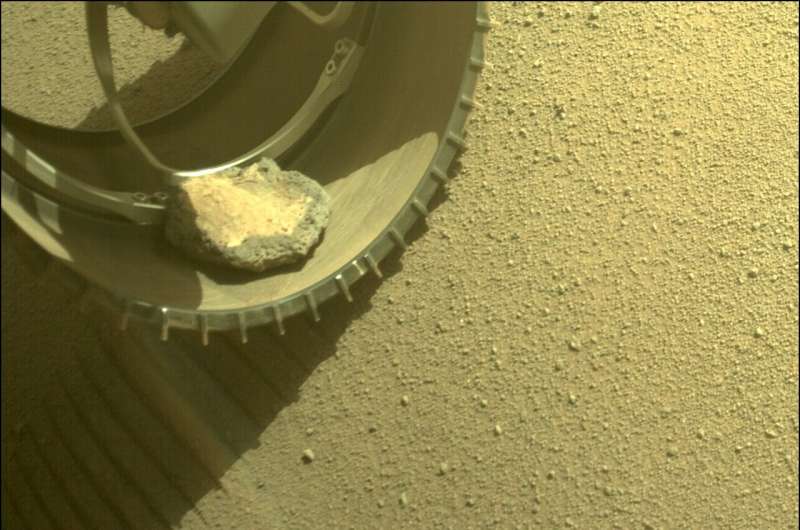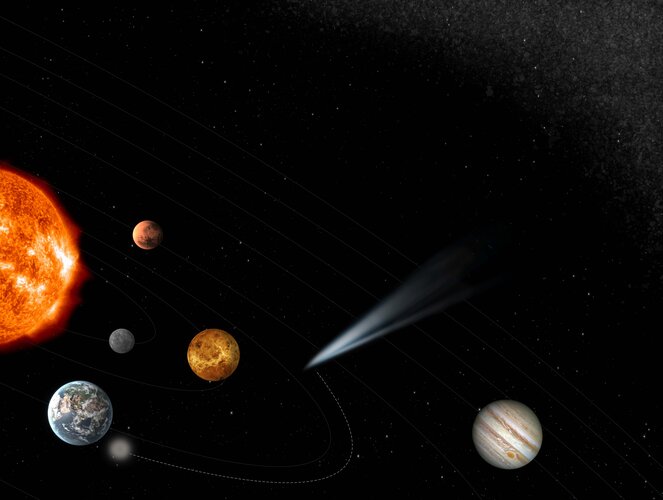
Copernical Team
Perseverance has a pet rock

How do you choose a rock on Mars? Sometimes you don't—it chooses you.
For the past four months, Perseverance has had an unexpected traveling companion. Back on sol 341—that's over 100 sols ago, in early February—a rock found its way into the rover's front left wheel, and since hitching a ride, it's been transported more than 5.3 miles (8.5 km). This rock isn't doing any damage to the wheel, but throughout its (no doubt bumpy!) journey, it has clung on and made periodic appearances in our left Hazcam images.
This is not the first time a rock has hitched a ride on a Mars rover mission.
Comet Interceptor approved for construction

ESA’s Comet Interceptor mission to visit a pristine comet or other interstellar object just starting its journey into the inner Solar System has been ‘adopted’ this week; the study phase is complete and, following selection of the spacecraft prime contractor, work will soon begin to build the mission.
Charting sea level from space
 Video:
00:12:21
Video:
00:12:21
Satellite images of our planet have become essential to our survival, offering a new outlook of our world. With rising seas being one of the biggest threats to society, satellite altimeter missions such as Copernicus Sentinel-6 are essential in monitoring global and regional changes in sea level.
Unbeknown to many, the island of Crete, Greece, plays an important role in the Copernicus satellite altimetry constellation and on an international stage. Satellite altimetry data have to be continuously monitored at the ESA’s Permanent Facility for Altimetry Calibration where different techniques have pioneered the use of transponders to provide the
Hubble captures largest near-infrared image to find universe's rarest galaxies
 An international team of scientists has released the largest near-infrared image ever taken by NASA's Hubble Space Telescope, enabling astronomers to map the star-forming regions of the universe and learn how the earliest, most distant galaxies originated. Named 3D-DASH, this high-resolution survey will allow researchers to find rare objects and targets for follow-up observations with the recent
An international team of scientists has released the largest near-infrared image ever taken by NASA's Hubble Space Telescope, enabling astronomers to map the star-forming regions of the universe and learn how the earliest, most distant galaxies originated. Named 3D-DASH, this high-resolution survey will allow researchers to find rare objects and targets for follow-up observations with the recent Researchers create simulations studying the lifecycle of ancestor galaxy cities
 For the first time, researchers have created simulations that directly recreate the full life cycle of some of the largest collections of galaxies observed in the distant universe 11 billion years ago, reports a new study in Nature Astronomy.
Cosmological simulations are crucial to studying how the universe became the shape it is today, but many do not typically match what astronomers obse
For the first time, researchers have created simulations that directly recreate the full life cycle of some of the largest collections of galaxies observed in the distant universe 11 billion years ago, reports a new study in Nature Astronomy.
Cosmological simulations are crucial to studying how the universe became the shape it is today, but many do not typically match what astronomers obse Cosmological gravitational waves: A new approach to reach back to the Big Bang
 Operating observatories around the globe target sky regions characterized by low contamination from Galactic radiation looking for the imprint of Cosmological Gravitational Waves (CGWs) produced during Inflation, the mysterious phase of quasi-exponential expansion of space, in the very early Universe.
A new study by the POLARBEAR collaboration, led by SISSA for the part concerning the inte
Operating observatories around the globe target sky regions characterized by low contamination from Galactic radiation looking for the imprint of Cosmological Gravitational Waves (CGWs) produced during Inflation, the mysterious phase of quasi-exponential expansion of space, in the very early Universe.
A new study by the POLARBEAR collaboration, led by SISSA for the part concerning the inte Balmy Days on Mars - Sol 3496
 Our drive was successful, and we ended with some lovely flat bedrock with some gorgeous veining running through it. As APXS payload uplink lead today, I saw several targets that the APXS team would have loved to analyze.
Sadly, the timing didn't work in our favour today. APXS prefers temperatures below -20 C - the colder it is, the better the data quality is. But daytime temperatures in Ga
Our drive was successful, and we ended with some lovely flat bedrock with some gorgeous veining running through it. As APXS payload uplink lead today, I saw several targets that the APXS team would have loved to analyze.
Sadly, the timing didn't work in our favour today. APXS prefers temperatures below -20 C - the colder it is, the better the data quality is. But daytime temperatures in Ga Why does the Moon look close some nights and far away on other nights?
 Some nights the Moon seems really close and bigger than usual.
One summer evening when I was a child, I remember being mystified and then startled at a huge round shape slowly creeping up behind my friend Nancy's house, which sat on a hill on the other side of our village.
At some point I suddenly realized it was the Moon, and I ran yelling through the garden to tell my dad and get h
Some nights the Moon seems really close and bigger than usual.
One summer evening when I was a child, I remember being mystified and then startled at a huge round shape slowly creeping up behind my friend Nancy's house, which sat on a hill on the other side of our village.
At some point I suddenly realized it was the Moon, and I ran yelling through the garden to tell my dad and get h A mathematical tool to help understand fractal structure of quark-gluon plasma
 Quark-gluon plasma (QGP) is a state of matter existing at extremely temperatures and densities, such as those that occur in collisions of hadrons (protons, neutrons and mesons). Under so-called "normal" conditions, quarks and gluons are always confined in the structures that constitute hadrons, but when hadrons are accelerated to relativistic velocities and made to collide with each other, as th
Quark-gluon plasma (QGP) is a state of matter existing at extremely temperatures and densities, such as those that occur in collisions of hadrons (protons, neutrons and mesons). Under so-called "normal" conditions, quarks and gluons are always confined in the structures that constitute hadrons, but when hadrons are accelerated to relativistic velocities and made to collide with each other, as th SCOUT and LEOcloud collaborate on next gen space domain awareness services
 SCOUT Inc., a company developing next-generation space safety of flight and autonomous proximity operations services, and LEOcloud Inc., a company offering a scalable space-based, multi-cloud Infrastructure as a Services (IaaS) announced they have signed a Letter of Intent (LOI) to work jointly to enhance space operations safety.
The collaboration is focused on integrating SCOUT's Space Do
SCOUT Inc., a company developing next-generation space safety of flight and autonomous proximity operations services, and LEOcloud Inc., a company offering a scalable space-based, multi-cloud Infrastructure as a Services (IaaS) announced they have signed a Letter of Intent (LOI) to work jointly to enhance space operations safety.
The collaboration is focused on integrating SCOUT's Space Do 
